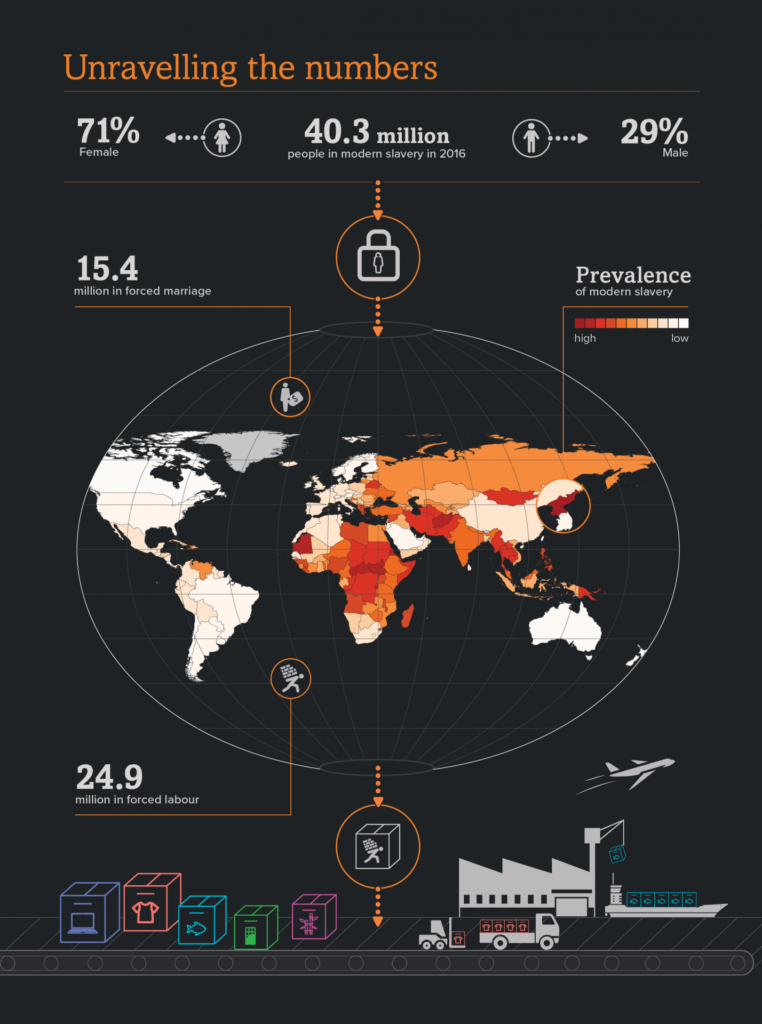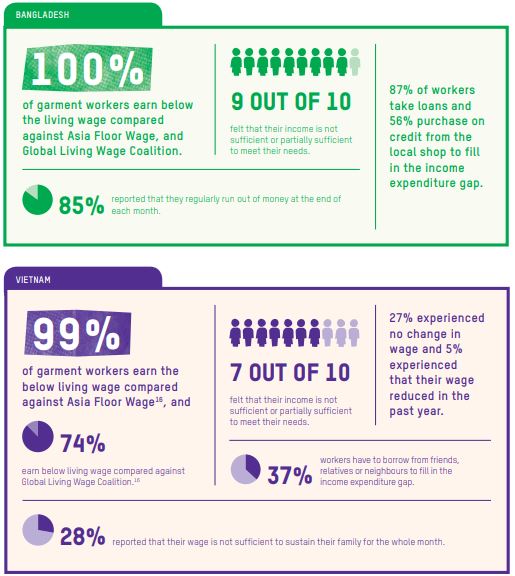With growing access to research and reports, excuses are thinning for consumers, and non-existent for brands claiming to be ignorant of exploitation and slavery throughout the fashion supply chain.
A recent report released by Oxfam Australia – Made in Poverty, The True Price of Fashion, provides one of the most comprehensive looks at the lives of the women and men making clothes for the Australian market to-date, and the results are condemning.
“They are unable to escape. This is not a one-off
story of hardship, but a systemic exploitation of people – mostly women – who are simply trying to make ends meet.” – What She Makes, Oxfam Report 2019
They provide evidence that without a doubt, the garment makers interviewed from Bangladesh and Vietnam – making up around 10% of all clothing imported to Australia – are trapped in bondage and unable to provide for their basic living needs, due to the wages they are paid. They are victims of what is known as modern-slavery.
What is Modern Slavery
A negligible advancement on chattel slavery – the treatment of people as property, entirely without remuneration – modern slavery refers broadly to a number of practices causing the enslavement or bondage of a person, existing in society today. This may be through forced labour, debt bondage, forced marriage, human trafficking, or other slavery practices.
The International Labour Organisation estimates over 40 million people are held in modern slavery:
- In 2016, an estimated 40.3 million people were in modern slavery; made up of 24.9 million in forced labour and 15.4 million in forced marriage.
- That means there are 5.4 victims of modern slavery for every 1,000 people in the world.
- 1 in 4 victims of modern slavery are children.
- Of the 24.9 million people trapped in forced labour, 16 million people are exploited in the private sector (e.g. domestic work, construction or agriculture); 4.8 million in forced sexual exploitation, and 4 million in forced labour imposed by state authorities.
- Women and girls are disproportionately affected by modern slavery, accounting for almost 29 million – 71% of the overall total.
The results of a collaborative effort between the International Labour Organization and the Walk Free Foundation, their report focuses on the main issues of forced labour and forced marriage.
“Although modern slavery is not defined in law, it is used as an umbrella term that focuses attention on commonalities across these legal concepts. Essentially, it refers to situations of exploitation that a person cannot refuse or leave because of threats, violence, coercion, deception, and/or abuse of power.”
We need to remember that this is a global humanitarian issue in which we all play a part – not just a concern for Australian supply chains, and not simply for garment makers abroad.
The Global Slavery Index outlined that in 2018, there were 15,000 Australians living in modern slavery. And that’s just the people who are visible to reporting.

Source: www.globalslaveryindex.org
Modern Slavery Act
Until 2018, Australia was noted by the Global Slavery Index as one of 12 countries not taking action on slavery in supply chains, when it was announced Australia would introduce supply chain transparency laws in the second-half of that year.
Following three years after the introduction of a Modern Slavery Act in the UK, the Australian Parliament introduced the Australian Modern Slavery Act on 10th December 2018. An act which in their own words which proposes to “..require some entities to report on the risks of modern slavery in their operations and supply chains and actions to address those risks, and for related purposes”.
Effective from the 1st of Jan 2019 , the Act requires that entities operating within Australia with a revenue of A$100 million or above, submit an annual report or Modern Slavery Statement. The Statement should outline the company’s action taken to assess and address modern slavery risks in their operations and supply chains, which will then be made public through an online central register.
Australian businesses who do not meet the revenue requirement are still able to report voluntarily.
A journalistic review conducted by the Conversation of 101 company statements, three years after the UK Modern Slavery Act was enacted, found that only 61% of statements were signed by a Board representative, despite this being a legislative requirement. If the UK legislation is the model for what has been implemented in Australia, it calls to question whether the Act is capable of driving significant change in the practice of businesses whose corporate strategies do not currently line up with this new way of doing business.
Everyone Deserves a Living Wage
The concept of a living wage is the expectation that a full-time worker, in exchange for the ordinary hours worked, can afford to pay for their basic needs to live in safety and good health, as a minimum.
This is not to be confused with the “legal minimum wage” which in many developing countries is not enough to pay for the bare essentials, and in those cases becomes a systematic contributor to lifelong poverty.
The essential basics under a living wage are perceived to include; sufficient, nutritious food, adequate housing, medical treatment, clothing, transportation, utilities, childcare, education, and any other essential needs including the ability to save for the future or unplanned events.
So how do garment workers making Australian clothing overseas fare according to the latest reports?

Oxfam Australia – “What She Makes” Report 2019
The message is clear; “A living wage is not a luxury. It is a minimum that all working people should be paid if they are to escape poverty. A living wage should be earned in a standard work week (no more than 48 hours) by a worker and be sufficient to afford a decent standard of living for the worker and her or his family.”
“The practices of big brands actively keep wages low, and force tough choices onto workers and factory management.”
“The first step is for iconic Australian brands to commit to a clear strategy and timeline that will help guarantee the payment of living wages to the workers making their clothes.” Oxfam decrees.
To comply with a living wage pay arrangement, companies should conduct regular audits, and adhere to the most well-documented benchmarks, the most widely accepted currently being the Asia Floor Wage and the Global Living Wage Coalition, as well as allowing collective bargaining agreements by their workers.
Power for Change Lies with Consumers
Fashion brands themselves are vehicles for change, and it’s encouraging that a growing number are establishing ethical and sustainable strategies into the core DNA of their operations, but an effective end to the exploitation of garment workers is achieved when educated, conscious consumers hold the brands they buy from accountable.
This can be achieved by;
1. Voting with your dollar – Supporting brands who support their makers with a living wage and fair conditions.
2. Writing them an email – Explain why the ethical treatment of garment workers is important to you personally, as a consumer, and why you’ll take your business elsewhere if they can’t answer adequately.
2. Calling them out publicly – After researching the brand’s website, if you can’t find sufficient information or any public statement regarding transparent, ethical manufacturing, use the Fashion Revolution call to action hashtag #whomademyclothes, and let them know that future buying decisions depend on their answer.
If we don’t buy it, they’ll stop making it.
The buck stops with us, and the purchases we make define the future that we willingly and knowingly contribute to. The first step is always education, and once we know, there are no excuses not to act.
Written by Sophie Newman – Editor, Ethical Fashion Review.
Header Image Credit: elCarito via Unsplash
Sources –
Oxfam Australia 2019 “Made In Poverty” Report –https://whatshemakes.oxfam.org.au/wp-content/uploads/2019/02/Made-in-Poverty-the-True-Price-of-Fashion.-Oxfam-Australia..pdf
Global Slavery Index – https://www.globalslaveryindex.org/2018/data/country-data/australia/ , https://www.globalslaveryindex.org/2018/findings/highlights/
Global Estimates of Modern Slavery: Forced Labour and Forced Marriage – https://www.ilo.org/global/publications/books/WCMS_575479/lang–en/index.htm
Suggested Reading –
Slave to Fashion, by Safia Minney
Oxfam Australia – What She Makes Campaign –https://whatshemakes.oxfam.org.au/
International Labour Organization – https://www.ilo.org/
Walk Free Foundation – https://www.minderoo.com.au/walk-free/
Asia Floor Wage – https://asia.floorwage.org/calculating-a-living-wage
Global Living Wage Coalition – https://www.globallivingwage.org/



1 Comment
This Vegan Watch Brand is Changing the Definition of Style – Ethical Fashion Review™ · 8 May 2019 at 11:35AM
[…] more people moving to a vegetarian diet , the well-documented human rights issues in fashion and environmental impacts of production, there’s still a lot to consider when making a […]
Comments are closed.